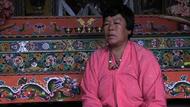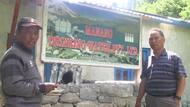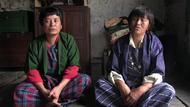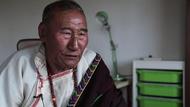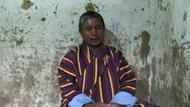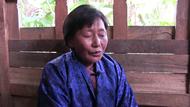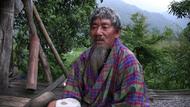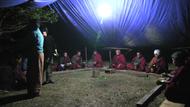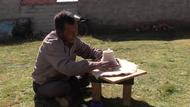Video Overview
Dondrup Tsering gives a chronology of his educational and teaching experiences and introduces some Chongyé oral histories.
- Lhokha
- Chonggyé Khül
- Chonggyé
- དོན་གྲུབ་ཚེ་རིང་ Döndrup Tséringལྟ་སོ་སོའི་སྐྱེས་ཡུལ་བྱས་ནས་འཕྱོངས་རྒྱས་རྫོང་རྒྱལ་མ་ཤངས་བྱས། བཀྲ་ཤིས་གྲོང་ཚོ་བྱས། ཨཱ་ནི་སོ་སོའི་མིང་ལ་དོན་གྲུབ་ཚེ་རིང་།I was born in Tashi village here in Chongyé Gyelma township. My name is Döndrup Tsering.
- སྐྱེས་ཡག་དུས་ཚོད་ ༡༩༦༣ ད་ལོ་ལོ་ ༤༣I was born in 1963. I am 43 now.
- ལས་ཀར་བཞུགས་ཡ་དུས་ཚོད་ ༡༩༧༥ ཨཱ་ནི་ལས་ཀར་བཞུགས་ནས་ད་བར་ལོ་ ༣༠ ཨཱ་ནི་སོ་སོར་བསླབ་གྲར་འགྲོ་ཡག་གི་དུས་ཚོད་ཆ་བཞག་ན་ལོ་ཆུང་ཆུང་ནས་དང་ཐོག་མར་ཤང་ཀྱི་སློབ་གྲྭར་ཕྱིན།I joined the workforce in 1975 and has been working for the past 30 years. When I was young, I went to township school.
- ཨཱ་ནི་དེ་ནས་༧༣ལོར་ཨཱ་ནི་འཕྱོངས་རྒྱས་རྫོང་ལྟེ་བའི་སློབ་གྲྭ་ལ་ཡར་ཡོང་། ཨཱ་ནི་༧༣ལོ་ནས་༧༥བར་ཨཱ་ནི་ལྟེ་བའི་སློབ་གྲྭ་ལ་སློབ་སྦྱོང་བྱས་པའི་རྗེས་ལ་ཨཱ་ནི་དེ་ནས་མཐར་ཕྱིན། སློབ་གྲྭ་ཐོན།Then in 1973, I went to central school in Chongyé district where I studied for another two years before graduation.
- ཨཱ་ནི་ཐད་ཀར་སྐབས་དེ་དུས་ཙམ་པ་བསླབ་གྲྭ་ཆེན་པོ་དང་འབྲིང་རིམ་སློབ་གྲྭ་དེ་འདྲས་འགྲོ་ཡག་གི་གོ་སྐབས་བཀྲེན་པོ་བྱས། ཨཱ་ནི་བསླབ་གྲའི་ཆ་རྐྱེན་ཡག་པོ་མེད་པ། ཨཱ་ནི་བསླབ་གྲྭའི་གྲངས་འབོར་ཉུང་ཉུང་། དེ་འདྲས་སོང་ཙང་ཨཱ་ནི་ལམ་སེང་འཕྱོངས་རྒྱས་ལྟེ་བའི་བསླབ་གྲྭ་ཐོན་ནས་ཐད་ཀར་སྤྱི་ཚོགས་སྒང་ལ་ཕྱིན།In those days, there were no opportunities to attend university or even middle school. Besides, the schools were poorly equipped, and not many children attend school at all. So soon after graduation from the central school in Chongyé, I started working.
- ཨཱ་ནི་སྤྱི་ཚོགས་སྒང་ལ་སླེབས་པའི་རྗེས་ལ་ཏག་ཏག་༧༥ལོ་འདའི་ཨཱ་ནི་སོ་སོའི་ཕ་ཡུལ་ལ་ཨཱ་ནི་དམངས་བཙུགས་སློབ་གྲྭའི་དགེ་རྒན་བྱེད་མཁན་མེད་པ། དགེ་རྒན་ཧ་ཅང་བཀྲེས་པའི་གནས་ཚུལ་འོག་ལ། ཨཱ་ནི་སློབ་གྲྭ་ཐོན་ནས་ཟླ་བ་གཅིག་མ་ཕྱིན་གོང་ནས་ཨཱ་ནི་ལམ་སེང་དམངས་བཙུགས་སློབ་གྲྭ་ལ་ཕྱིན་བྱས། ཨཱ་ནི་དགེ་རྒན་ལས་ཀ་འདུག་སེ་བྱས།At that precise moment in 1975, there was a severe shortage of teachers in a public school in my hometown. Under that circumstance, I went to the school and became a teacher a month later after graduating from school.
- འོ་འདི་ནས་ལྟ་༧༥ལོ་འདའི་ཟླ་བ་བདུན་པ་འདི་ནས་ཨཱ་ནི་དངོས་སུ་དགེ་རྒན་ལས་ལ་བྱས་བྱས། ཐོག་མར་བཀྲ་ཤིས་ཤང་སྐབས་དེ་དུས་ཙམ་པ་དམངས་བཙུགས་སློབ་གྲྭ་ཟེར་གྱི་ཡོག་རེད། འོ་འདའི་སློབ་ཚན་འཁྲིད།So in July 1975, I started working as a teacher. At that time, the school in Tashi township was called Public School. There I taught classes.
- ༧༥ལོ་ནས་ཨཱ་ནི་ལོ་དྲུག་ཙམ་རིང་ཡ་གིར་བསྡད། ཨཱ་ནི་༡༩༨༠ལོ་ལ་ལྷོ་ཁ་ས་ཁུལ་དགེ་འོས་སློབ་གྲྭའི་དབུ་བཙུགས་པའི་བོད་ཡིག་གི་ཆེད་བཙུགས་འཛིན་གྲྭ འོ་འདའི་ཨཱ་ནི་ལོ་གཅིག་སློབ་སྦྱོང་བྱས་པའི་གོ་སྐབས་རག་པ་འདའི་ཕྱིན།Starting from 1975, I served the school for the next six years. In 1980, I got an opportunity for a one-year teacher training program for the Lhokha region at the newly established Teacher Training School for Tibetan language teacher.
- ཨཱ་ནི་༨༠ལོ་ལ་ཕྱིན་༨༡ལོ་ཐོན། ཨཱ་ནི་ལོ་གཅིག་འདུག་སེ་དགེ་འོས་སློབ་གྲྭ་ལ་ཆེད་མངགས་ལྟ་བོད་ཡིག་གི་ངོ་ཤེས་དང་། བོད་ཡིག་རྨང་གཞི་བྱས་བྱས་ཁོ་ན་སྦྱངས་བྱས་ཨཱ་ནི་ལོ་གཅིག་བོད་ཡིག་ཆེད་ལས་ཟབ་སྦྱོང་ལ་སློབ་སྦྱོང་བྱས།So I attended the program in 1980 and completed training in the following year. At the training school, I studied the Tibetan language right from the fundamentals.
- ལྟ་འོ་དེ་ནས་མཐར་ཕྱིན་པའི་རྗེས་ལ་༨༡ལོ་ནས་ཨཱ་ནི་ཡར་ཐན་པོའི་རྗེས་ལ་ཡང་དམངས་བཙུགས་སློབ་གྲྭ་ནས་ཨ་ནི་ཤན་ལྟེ་བའི་སློབ་གྲྭ་ལ་དགེ་རྒན་མར་འཐེན་འོ་འདི་བྱས།After completion in 1981, I was transferred from the public school to the county school.
- ཨཱ་ནི་ཤན་ལྟེ་བའི་སློབ་གྲྭ་ལ་ཡ་༨༡ལོར་སླེབས་ནས་ཨཱ་ནི་དེ་ནས་ཤན་ལྟེ་བའི་སློབ་གྲྭ་ལ་ཡ་གཙོ་བོ་བོད་ཡིག་སློབ་ཚན་འཁྲིད། ཨཱ་ནི་ཞོར་ལ་ཡཱ་སྤྱི་ཚོགས་དང་ཡང་ན་གཞན་དག་ཆབ་སྲིད་ལ་སོགས་པ་འོ་འདི་འདྲས་ཀྱི་སློབ་ཚན་འཁྲིད། འདུག་སེ་དགེ་རྒན་ལོ་ཁ་ཤས་བསྡད་པ་རེད།At the county, I mainly served as a Tibetan language instructor since 1981. Besides that, I also social and civic classes. Like that, spent quite a few years there.
- ཨཱ་ནི་༡༩༨༡ལོ་ནས་༨༥བར་སླེབས་དུས་ཙམ་ལ་སྔར་རྒྱུན་ལྷོ་ཁ་ས་ཁུལ་དགེ་འོས་སློབ་གྲྭའི་འདི་ཞིག་ཚུགས་པ་རེད། རྒྱ་སྐད་བྱས་ན་ "ཀན་འུ་པན།" [Ch. 干部班] བོད་སྐད་བྱས་ན་ལྟ་ "ལས་བྱེད་ཆེད་བཙུགས་འཛིན་གྲྭ་" ཟེ་བྱས། ཨཱ་ནི་འདི་འདུག་སེ་རེད། འཆར་གཞི་བྱས་ནས་ལོ་གཉིས། སློབ་སྦྱོང་བྱས་ཡག་གི་དུས་ཚོད་དེ།That was between 1981 and 1985. At the end of that year, something in Chinese called "Ganbuban" was established in Lhokha region. In Tibetan, it is called "lé jé ché tsuk dzin dra." [Teacher training class] It was a two-year program.
- མར་འགྲོ་དུས་ཙམ་པ་ཡིག་ཚད་བཏང་། ཡར་ཐོན་དུས་ཙམ་པ་ཡིག་ཚད་བཏང་། ཡིག་ཚད་ལོན་བྱས་ཐོན་སོང་ན་ཨཱ་ནི་ཀྲུང་ཀྲོན་ཝན་བིན་[བོད་སྐད་ནང་འབྲིང་རིམ་སློབ་གྲྭའི་ཆུ་ཚད་] ཡིག་ཚད་དེ་མ་ལོན་ན་ཀྲུང་ཀྲོན་འོ་འདི་མེད་པ་བྱས།You have to take a written test before joining the program, take another test to graduate from that school. If you passed that text, you would be awarded a diploma. Otherwise, you won't receive the certificate.
- འོ་འདི་ལྟ་ལོ་གཉིས་ནང་རྦད་ལྟ་སློབ་ཚན་ཆ་བཞག་ནའི་ད་ཡོད་ཀྱི་ཀྲུང་ཀྲོན་གྱིས་སྦྱངས་ཡག་སློབ་ཚན་ཆ་ཚང་སྦྱངས་དགོས་ཡགFor that program, you had to specifically study all the textbooks used for that level available at the time.
- ཨཱ་ནི་འདི་འདྲས་བྱས་སོ་སོའི་སློབ་སྦྱོང་བྱས་ཡག་ཐོག་ལ་དཀའ་ངལ་འདི་འདྲས་ལྟ་གཅིག་འདིའི་སྔོན་དང་བསྡུར་ན་མ་འདྲ་ཐུབ་པ་འདུག་ལའི་ལྟ་འདི་ཐད་ཀར་སོ་སོའི་ད་ལྟ་གཞུང་ལས་གལ་གལ་མེད་ཙང་། ཨཱ་ནི་འདི་དང་འབྲེལ་བ་ཡོད་པ་སོང་ཙང་འདའི་གང་གས་ལྟ་ཧུ་ཐག་འབད་ཐག་བྱས་སྦྱངས།Although I faced many difficulties throughout this program, giving that I don't have a stable government job at that moment and concerned with my career, I put much effort.
- ཨཱ་ནི་༨༥ལོར་། ༨༦བྱས། ༨༦ནས་༨༧ལོ་གཉིས་འདུག་སེ་བསྡད་བྱས་ཨཱ་ནི་གཞི་ནས་ཡིག་ཚད་བཏང་།So I studied for two years from 1986 to 1987 and took the test.
- ཨཱ་ནི་གཞུག་གུའི་ཡིག་ཚད་ལོན་བྱས་ཨཱ་ནི་ད་ལྟའི་ཀྲུང་ཀྲོན་འདའི་འོ་འདི་ནས་རག་པ་དང་། ལྟ་སོ་སོ་གཞུང་ལས་རག་ཡག་དེ། ཨཱ་ནི་ད་ལྟ། འོ་ད་ལྟ་བར་གཞུང་ལས་འདི་མ་གཞི་བཱ། འོ་འདི་འོ་འདྲས་སེ་རགI passed the text and received my diploma. So that is how I got the government job, and till now, that's the only job I have.
- ཨཱ་ནི་འདི་ནས་སྔ་རྒྱུན་ཤན་ངོས་ཕྱོགས་ལ་ཨཱ་ནི་སློབ་ཚན་ཁྲིད། ཨཱ་ནི་འདི་ནས་༡༩༩༣ལོ་ལ་བོད་ལྗོངས་སློབ་གྲྭ་ཆེན་མོའི་གསོ་སྦྱོང་པུའུ་[སྡེ་ཚན་]ཨཱ་ནི་དགེ་རྒན་ཡང་གསོ་སྦྱོང་ཞིག་གཉེར་གནང་། ཨཱ་ནི་འོ་འདའི་ཆེད་མངགས་བོད་ཡིག་སྦྱངས་མཁན་གྱི་འཕྱོངས་རྒྱས་ནས་བསླབ་གྲྭའི་ཨཱ་ནི་སོ་སོའི་བཀོད་སྒྲིག་གནང་། སོ་སོས་ཕྱིན།From then onward, I started teaching in the county school. In 1993, the Tibet University organized another training for Tibetan language teachers. They asked for one candidate from the Chongyé district, and the school chose me. So I went there.
- ཨཱ་ནི་འོ་འདི་རྦད་ལོ་གཅིག་ཨཱ་ནི་བོད་ཡིག་སྦྱངས། ཨཱ་ནི་འདིའི་རྨང་གཞི་ར་ལྟ། དང་ཐོག་མར་ཕྱི་ཕྱོགས་ལ་༨༠ལོ་ནས་༨༡བར་དུ་བོད་ཡིག་སྦྱངས་ནས་རྨང་གཞི་གཞི་འདིའི་སྒང་ལ་ཨཱ་ནི་ད་རེས་ཡང་བསྐྱར་གོ་སྐབས་འདི་འདྲས་རག་ཙང་ཨཱ་ནི་སེམས་ནང་སྦྱངས་སེམས་ཨེ་འདྲས་ཆེ་རུ་ཕྱིན།There I studied the Tibetan language for one year. Giving that I got an opportunity to study from 1980 to 1981, that opportunity to study one more year in the university to build upon my earlier basic enhanced my motivation to study.
- ཨཱ་ནི་བོད་ཡིག་ལྟ་སོ་སོས་ཏིག་ཙམ་ཧ་གོ་པའི་སྒང་ད་ལྟ་རྦད་གོ་སྐབས་ཡག་པོ་འདི་རག་ཙང་ཨཱ་ནི་རྦད་སློབ་སྦྱོང་བྱེད་ཡག་དང་འདི་པ་ཨཱ་ནི་རྦད་ལྟ་སོ་སོ་ལྟ་སེམས་ནང་ལྟ་སྦྱངས་སེམས་ལྟ་སྣང་བ་དེ་ལས་ཆེ་རུ་ཕྱིན། ཨཱ་ནི་འདུག་སེ་བྱས་འབད་པ་བྱས་བྱས་འོ་འདི་ནས་རྦད་བོད་ཡིག་རྨང་གཞི་ཚུགས་བྱས་འོ་འདི་འདྲས་སེ།As I already had some knowledge on the Tibetan language, that wonderful opportunity to study one more year greatly increased my interest. That's how I mastered the language.
- ཨཱ་ནི་འོ་འདའ་འདིའི་ལོ་གཅིག་ཟབ་སྦྱོང་དེ་བདེ་བླག་ངང་འཇུག་བསྒྲིལ། ཨཱ་ནི་༩༤ལོ་ཡི་ཟླ་བ་བདུན་པ་ནས་ཨཱ་ནི་བོད་ལྗོངས་སློབ་གྲྭ་ཆེན་པོའི་གསོ་སྦྱོང་པན་[ཟབ་སྦྱོང་འཛིན་གྲྭ་]ནས་ཐོན། ཨཱ་ནི་གཞི་ནས་ཚུར་ལོག་སླེབས།I completed the one-year training program. In July 1994, I completed the training program at the Tibet University.
- ཨཱ་ནི་རྨང་གཞི་བྱས་དེ་དུས་ཙམ་པ་སོ་སོ་ཕར་འགྲོ་དུས་ཙམ་པ་ཤན་ལྟེ་བའི་སློབ་གྲྭའི་དགེ་རྒན་ཡིན་ཙང་སྔ་རྒྱུན་ལྡེ་བའི་སློབ་གྲྭ་འགྲོ་དགོས་ཡོད་པ། དགེ་རྒན་བསླབས་ཡོད་དུས་ཙམ་པ་ལྟ་ཏིག་ཙམ་ཆུ་ཚད་འདི་ཡག་པོ་ཆགས།As I was already a teacher at the central school in the county before I joined the training program, I went back to the same school. By then, my academic level greatly improved.
- ཨཱ་ནི་སློབ་གྲྭའི་ནང་སྡོད་བཞུགས་རིང་རྒན་ལགས་དང་དེ་ཚོས་ལྟ་རྦད་ལྟ་སྟངས་དང་འོ་འདི་འདྲས་ཡག་པོ་བྱུང་བྱས་བྱས་ཨཱ་ནི་ཚུར་སླེབས་པ་དང་ལམ་སེང་ཨཱ་ནི་ཤན་འདི་ལ་ཡ་སློབ་འབྲིང་ལ་ཡ་ཨཱ་ནི་ཚུར་འཐེན། ༩༤ལོ་ནས། ཨཱན་ནི་༡༩༩༤ལོ་ནས་ད་བར་དུ་རྦད་ལྟ་འདི་ལ་རྦད་དེ་སློབ་འབྲིང་ནང་བསྡད་པ་རེད།As a result, it had a strong effect regarding my impression at the school. As soon as I arrived there, transferred to the county middle school. From 1994 onward, I have been serving in the school.
- ཨཱ་ནི་སློབ་འབྲིང་ནང་བསྡད་བྱས་གཙོ་ཆེ་ཆོས་ཡིན་ན་ལྟ་བོད་ཡིག་སློབ་ཚན་ཁྲིད། ཨཱ་ནི་ཞོར་ལ་འདི་འདྲས་པན་ཀྲུའུ་རན་[བོད་སྐད་འཛིན་གྲྭ་རྒན་དག]བྱས། ཨཱ་ནི་འོང་ཞོའོ་ལ་འགྲོ་དུས་ཙམ་པ་གཙོ་ཆེ་ཤོས་ཨཱ་ནི་བོད་ཡིག་སློབ་ཚན་ཁྲིད།During that period, I mainly served as a Tibetan language instructor, and I also served as a class supervisor. I mainly teach Tibetan.
- ཨཱ་ནི་ཞོར་ལ་ཡང་ལས་ཀ་གཞན་དག་འདི་འདྲས་བྱས། ཨཱ་ནི་བོད་ཡིག་སློབ་ཚན་ཁྲིད་པའི་བརྒྱུད་རིམ་ལ་ཆ་བཞག་པ་ཡིན་ན། ལྟ་ད་ལྟའི་ངོས་ནས་ཆ་བཞག་པ་ཡིན་ན་ང་ཚོའི་ཀྲུང་ཞོལ་(བོད་སྐད་ནང་འབྲིང་རིམ་)ནང་ལོགས་ཆ་བཞག་ནང་ལོགས་ལྟ། འོ་བོད་ཡིག་སློབ་ཚན་ཁྲིད་མཁན་ནང་ལྟ་ལོ་ཡའི་དང་ལས་ཀ་བྱེད་ཡག་གི་ཀུང་(བོད་སྐད་ནང་ཞབས་ཞུ་)བྱས་ན་སོ་སོ་རིང་ཤོས་རེད་པ།Besides teaching, I also did some other works too. In the course of my teaching, I became the longest serving teacher at the middle school.
- ཨཱ་ནི་རྦད་སྒང་འགོ་ཁྲིད་ཡིན་ནའི་བཱ་འོ་དགེ་རྒན་གཞན་དག་གིས་སོ་སོར་རྦད་འདི་ར་བྱས་བྱས་བློ་འགེལ་བྱས་བྱས། རྦད་ལྟ་བོད་ཡིག་ཐོག་གནད་འགག་དང་ལྟ་འདི་པ་འདི་འདྲས་ཡིན་དུས་བློ་འགེལ་གང་གས་འདི་འདྲས་བྱས་ཙང་། ཨཱ་ནི་སོ་སོས་རྦད་དེ་གཅིག་འཇུག་གཉིས་མཐུད་ལྟ་ལས་ཀའི་ཐོག་ལ་སེམས་ཤུགས་ཆེ་རུ་བཏང་ཡག་དང་། ཡང་མིན་ལྟ་ལས་ཀའི་བྱེད་སེམས་དེ་བས་ཆེ་རུ་ཕྱིན།And I am trusted by my superiors as well as by my junior colleagues. Whenever there is task relating to the Tibetan language, I became the one trusted by all members of the school. From my part, I never let them down and doing my best.
- ཨཱ་ནི་སྔ་ཕྱི་ཕར་ནས་ཕུལ་བྱུང་མ་སོང་ནའི་དགེ་རྒན་དེ་འདྲས་དང་། ཡང་ན་ཕུལ་བྱུང་གི་པན་ཀྲུའུ་རན་[བོད་སྐད་ནང་འཛིན་གྲྭ་རྒན་བདག་]དང་། ཨཱ་ནི་ལྷག་དོན་དུ་ཕར་ནས་ཚུར་༡༩༩༤ལོར་ཐོན་ཙང་། ཞིའི་ཙང་ཏཱ་ཞོལ་[བོད་སྐད་ནང་བོད་ལྗོངས་སློབ་གྲྭ་ཆེན་མོ་] ༩༣, ༩༤ལོར་ཐོན་ཙང་།Time and again, I received many awards for my services, such as Outstanding Teacher, Outstanding Supervisor, and so on. Since I completed my training program at the Tibet University in 1994,
- འདིར་ཚུར་སླེབས་པ་དང་ལམ་སེང་འདི་གཅིག་སྤྲད་པ་རེད་འདི་ནས། འོ་ད་ལྟ་སློབ་འབྲིང་སླེབས་མ་བསྡད་པའི་ཞོའོ་ཞོལ་[བོད་སྐད་ནང་སློབ་གྲྭ་ཆུང་བ་]ཐོན་བྱས་བྱས་སློབ་འབྲིང་ནང་སླེབས་པའི་དེ་དུས་ཙམ་པ། ང་ཚོའི་སློབ་འབྲིང་ནང་ཡུད་ཁའི་[བོད་སྐད་ནང་གྲ་སྒྲིག་]ཟེར་གྱི་ཡོག་རེད།as soon as I arrived, I was put in charge of a class made up of new graduates who had just joined the middle school. In our school, it was called yükha [Chinese term for preparation class].
- འདི་ནས་སློབ་འབྲིང་ནང་ལོ་གསུམ་བསྡད་དགོས་པ་ལགས། ཁྲུའུ་ཡི། ཁྲུའུ་ཨར། ཁྲུའུ་སན། [བོད་སྐད་ནང་འཛིན་གྲྭ་དང་པོ། གཉིས་པ། གསུམ་པ་] སྐབས་དེ་དུས་ཙམ་པ་ཡུད་ཁའི་ཟེར་ལོ་གཅིག་བསྡད། ཨཱ་ནི་དེ་ནས་ཁྲུའུ་ཡི། ཁྲུའུ་ཨར། ཁྲུའུ་སན། ལོ་བཞི་བསྡད་དགོས་ཀྱི་རེད་སློབ་འབྲིང་ནང་ལ།The students have to spend three years before they graduate, we called them [in Chinese] as chuyi, chuer, and chusan. In total, they stay for four years in middle school.
- ཨཱ་ནི་འདུག་སེ་བྱས་སོ་སོའི་ཚུར་སླེབས་པ་དང་ལམ་སེང་༩༤ལོ་འདའི་ཞོའོ་ཞོལ་[བོད་སྐད་ནང་སློབ་ཆུང་]ཐོན་མ་ཐག་པའི་འཛིན་གྲ་ཞིག་སོ་སོ་ཨཱ་ནི་ལྟ་ཀྲུང་ཞོལ་ནང་སྤྲད་པ་རེད། ཨ་ནི་སོ་སོས་འདི་༩༤ནས་༩༤ ༩༥ ༩༦ ༩༧ ལོ་བཞིའི་ནང་རྦད་ཡུད་ཁའི་ནས་ཡར་འདི་བྱས་བྱས་རྦད་ལོ་བཞི།So soon after I come to the school in 1994, I was given a class who had just completed their primary school. And I had supervised the class for the next four years from 1994 till 1997, the year when the batch would graduate.
- ཨཱ་ནི་འོ་འདི་འདྲས་བྱས་བྱས་འདི་ནས་༩༤ནས་རྦད་ལྟ་སློབ་འབྲིང་ལ་སླེབས་མ་ཐག་པའི་བསླབ་གྲགས་འདི་གས་ཨཱ་ནི་ལྟ་རྦད་སོ་སོས་འདི་ནས་ཡུད་ཁའི་ནས་ཡར་བསླངས། ཨཱ་ནི་འདི་གས་ཏག་ཏག་སྐབས་འཁེལ་བ་ཞིག་བསླབ་གྲགས་འདི་གས་སྦྱངས་སེམས་ཆེན་པོ་ར་བྱས།Like that, since 1994 I started supervising the class. Coincidentally, the class was made up of students who were highly motivated.
- ཨཱ་ནི་སོ་སོའི་ལྟ་སྟབས་སྟབས་ཀྲུང་ཞོལ་ནང་ལས་དང་པོ་རེད་པ། དང་པོ་ཡིན་ཙང་སེམས་ཤུགས་ར་ཞིག་སླེབས། བསླབ་གྲ་གས་འཛིན་གྲྭ་འགྱུར་ལྡོག་གཅས་མ་བཏང་ཡུད་ཁའི་ནས་ཁྲུའུ་ཡི། ཁྲུའུ་ཨར། ཁྲུའུ་སན་སེ་བསླབ་གྲྭ་མ་ཐོན་བར་དུ་རྩིས་སྤྲད་བཞག་པ་འཛིན་གྲྭ་དེ།And also as it was my first work at the middle school, I was highly motivated by all these factors. The school also made me continuously lead the class through all stages of chuyi, chuer, and chusan without making any change.
- ཨཱ་ནི་སོ་སོས་འཛིན་གྲྭ་འདའི་པན་ཀྲུའུ་རན་བྱས་སློབ་ཚན་བོད་ཡིག་སློབ་ཚན་འཁྲིད། ཨཱ་ནི་ཏག་ཏག་འདི་འདྲས་ཤིག་བྱས་བྱས་བརྒྱུད་རིམ་ནང་སོ་སོས་རྦད་ཐབས་ཤེས་དང་འདི་པ་གང་བྱེད་ཐུབ་ནའི་ཡག་པོ་ར་བྱས། ཨཱ་ནི་བསླབ་གྲགས་ཀྱིས་ཡག་པོ་ར་ཅིག་སྦྱངས།I was a class supervisor, and I taught the Tibetan language. I put a lot of efforts and the students also worked very hard.
- ཨཱ་ནི་གཞུག་གུ་གཞུག་གུ་འདའི་བསླབ་གྲྭ་འདི་གས་ཐོན་དུས་ཙམ་པ་བསླབ་གྲགས་ངས་ཁྲིད་ཡག་གི་བསླབ་གྲྭ་འདིའི་འཛིན་གྲྭ་འདི་ང་ཚོ་ལྷོ་ཁ་ས་ཁུང་ནང་ལོགས་ནས་སློབ་སྦྱོང་སྦྱངས་ཀྲང་[བོད་སྐད་ནང་གཟེངས་བསྟོད་]དང་པོ་མང་པོ་འགྲིག་སོང་།At the time of graduation, the class I led received many first position awards in the whole Lhokha region.
- ཨཱ་ནི་སྐད་གྲགས་ཡོད་པའི་འདི་པ་བསླབ་གྲྭ་དཔེར་ན་གྲྭ་ནང་ཀྲུང་ཞོལ་[སློབ་འབྲིང་]ཟེར་ཡག ལྷོ་ཀའི་ཡིད་ཀྲུང་[སློབ་འབྲིང་དང་པོ།]ཟེར་ཡག་དེ་ཚོ་སྐབས་དེ་དུས་ཙམ་ལ་སྐད་གྲགས་ཡོད་རེད་འདའི་ཨཱ་ནི་བོད་ཡིག་གི་ཏང་ཏེའི་གྲང་ལྕི་[བོད་སྐད་ནང་སྦྱངས་འབྲས་]དེ་འཕྱོངས་རྒྱས་སློབ་འབྲིང་གས། ལྟ་སོ་སོ་ལའི་རྦད་སྐབས་དེ་དུས་ཙམ་པ་༩༧ལོར་འདའི་སློབ་ཚན་ཡག་པོ་ཁྲིད་པའི་ཅོའོ་ཞོལ་ཀྲིད་ལེང་ཇང་[བོད་སྐད་ནང་སློབ་ཁྲིད་གཟེངས་སུ་ཐོན་པའི་ལག་འཁྱེར་]འདི་འབྲས་ཤིག་སྤྲད་གནང་།Many other schools, such as Dranang Middle School and Lhokha First Middle School. They were very popular at the time. However, Choongyé middle school beat all of them in Tibetan language test result. For my achievement, I was awarded the certificate for quality teaching.
- བསླབ་གྲྭ་ཐོན་ཚད་ཡག་པོ་བྱུང་སོང་འདིའི་ལོ་འདའི། ཁྲང་ཇི་[འགྲུབ་འབྲས་]འདི་ལྷོ་ཁ་ཁོ་རའི་ནང་ལ་ང་ཚོ་བོད་ཡོངས་ནས་བྱས་པ་ཡིན་ན་ཨང་གསུམ་པ་རེད། འདི་འདྲས་སེ་བསླབ་གྲགས་ཡའི་སྦྱངས་སེམས་ཆེན་པོ་ར་སྐྱེས། ཨཱ་ནི་སོ་སོས་རྦད་འདི་སློབ་ཚན་འཁྲིད་ཡག་གི་འདི་ར་ཅིག་སྐྱེས། ཨཱ་ནི་འདི་འདྲས་སེ་བསྡད།That year, the passing rate was excellent. Regarding academic result, we were at the third position in entire Tibet [TAR]. It was the result of students' hard works and my dedication.
- ཨཱ་ནི་ད་ལྟ་བར་དུ་རྦད་མུ་མཐུད་ནས་ལྟ་སོ་སོའི་སྔས་ཀྱི་འགྲུབ་འབྲས་ལ་ལྟོས་པ་བྱས་མ་བསྡད་པར་རྦད་གཅིག་འཇུག་གཉིས་མཐུད་དང་། ཨཱ་ནི་བསླབ་གྲྭ་སློབ་མ་དེ་ཚོ་གཅིག་ལས་གཅིག་ཡག་ག་དང་། གཅིག་ལས་གཅིག་ཕུལ་སུམ་ཚོགས་པ་ཡོང་བའི་ཆེད་དུ་ཨཱ་ནི་རྦད་ལྟ་དཀའ་ལས་དང་མ་སོང་ནའི་བརྒྱབ་བྱས།Till now, I am continuously working hard and sincerely regardless of my past achievements so that the future students can achieve even better results.
- ལྟ་ལོ་འདི་ནས་རྩིས་པའི་ཧ་ལམ་༩༧ལོ་ནས་ད་ལྟ་བར་དུ་བྱས་ན་ལོ་བརྒྱད་ཙམ་འགྲོ་གི་ཡོད་བ། ལོ་བརྒྱད་ནང་ལོགས་ལ་ལོ་གཉིས་ཕུད་པའི་རྦད་སློབ་ཐོན་འཛིན་གྲྭ་རྐྱང་རྐྱང་ཁྲིད་བསྡད་བཱ།So accounting from 1997 onward, I have been at the school for eight years. Except for two years, I only taught classes in their final year at the middle school.
- ཨཱ་ནི་སློབ་ཐོན་འཛིན་གྲྭ་འཁྲིད་ཡག་ལ་བསམ་བློ་ནང་ལོགས་ལ་ཆ་བཞག་ནའི་རྦད་ལྟ་འདི་བསླབ་གྲྭ་ཐོན་མ་ཐུབ་བཞིན་རྦད་ཐད་ཀར་ཕྲུ་གུའི་མདུན་ལམ་དང་། ཁྱིམ་བདག་གི་དེ་དང་རེ་བ་དང་འབྲེལ་བ་ཡོད་ཙང་།Handing classes like that also put great pressure on you because if a student fails to pass the test, it's doing to affect that student's future career directly and there is also a great deal of expectation from the parents.
- རྦད་སེམས་ནང་དངངས་སྐྲག་འདི་འདྲས་ལྟ་འདི་འདྲས་འཛིན་གྲྭ་གཞན་མ་འདྲ་ཞིག་འདུག་འདའི། ལྟ་རྦད་འདི་སོར་ཁྲིད་དེས་ཕན་ཐོགས་ན་དངོས་གནས་དྲང་གནས་སོ་སོས་ལྟ་ལས་ཀ་བྱས་པ་དེ་ལ་འབྲས་བུ་ཐོན་པ་བསམ་བྱས་བྱས།So there is great mental pressure to led such classes compare to another one. However, if my efforts can bear fruits, it gives me a sense of satisfaction.
- ཨཱ་ནི་སོ་སོས་དཀའ་ངལ་ལ་མ་འཛེམས་པར་གྲུབ་པ་དང་། ཁྱིམ་བདག་གིས་རེ་བ་བྱས་འོ་འདི་འདྲས་བྱས་སྦྱངས་བྱས་ད་ལྟ་བར་དུ་ལས་ཀའི་ནང་ལ་འགྲུབ་འབྲས་གང་ལ་གང་མཚམས་ཤིག་ཐོན། ཨཱན་ཨི་སྒང་ལ་ལྟ་དབུ་ཁྲིད་དང་འདི་འདྲས་ཀྱིས་ཡག་པོ་བྱེད་ཀྱིས།So braving all the hardship and trying my best to fulfill the wishes of the parents. In the process, I believe I have achieved quite a lot.
- འོ་འདི་འདྲས་བྱས་ད་ལྟ་བར་དུ། ཡར་རྦད་ལྟ་འགོ་ཁྲིད་ཡིན་ནའི་བཱ། འོག་ང་ཚོའི་ཁྱིམ་བདག བསླབ་གྲགས་(སློབ་ཕྲུག་)གང་གས་ལྟ་སོ་སོས་ལྟ་ས་ཁྱབ་རྡོ་ཁྱབ་བྱུང་བྱས་རྒྱུས་ཡོད་པ་ཆགས། ཨཱ་ནི་རྦད་སོ་སོའི་ལའི་ཆ་བཞག་ནའི་ལྟ་ལས་ཀའི་ལྟ་རྦད། བྱེད་ཉིད་འདོད་པ་བྱས།My superiors, the parents, and the students I taught are all my acquaintance now, and they are everywhere. As a result, I became more dedicated.
- འོ་འདུག་སེ་ད་ལྟ་གོང་དུ་ཞུས་པ་སོ་སོའི་ལོ་རྒྱུས་ར་བཟོ་ར་རག་བསྡུས་ཤིག་འོ་འདི་འདྲས་ཤིག་ཡིན།What I have told you earlier in the brief history of my life.
- ལྟ་ད་ལྟ་གཤམ་འདའི་ཞུ་ཡག་གཙོ་བོ་འདི་ད་ལྟ་ང་ཚོའི་འཕྱོངས་རྒྱས་རྫོང་ཁོངས། ལྟ་ད་ལྟ་ཤང་[ཡུལ་ཤོག་]བྱས་ན་ཤར་མཛོད་ཤང་ཟེར་གྱི་བཱ། ཨཱ་ནི་གྲོང་ཚོ་འདི་ལ་ཡ་འཇུ་གྲོང་ཚོ་དམངས་ཁྲོད་ཁ་རྒྱུན་ལ་བྱས་ན་འཇུ་པ་འཇུ་པ་ཟེར་བཱ།Next, I will take about this place in Chongyé district. This village is called Ju, which is part of Shardzö village. According to folk saying, it is called Jupa.
- ཨཱ་ནི་འདི་རྒན་ལགས་ཚོས་ཐུགས་ཡི་གེ་འབྲི་སྟངས་བྱས་ནས་ "འཇུ་"བྲིས་ཀྱི་ཡོད་པ་དང་། བྱས་སང་ང་ཚོའི་ཡི་གེའི་ཐོག་ནས་གོ་བ་ལེན་དུས་ཙམ་པ་ "འཇུ་" སེ་ཟེར་དུས་ཙམ་ལྟ་དོགས་པའི་འཇུ་ཁང་། ལྟ་འདི་ཡིན་ཙང་དག་པའི་འཇུ་ཁང་གསུང་སང་ལྟ་འདི་ཧ་ཅང་དག་པའི་འཇུ་ཁང་ལབ་དུས་ཙམ་པ་ལུང་ཧ་ཅང་རྒྱ་ཆུང་ཆུང་བྱས། ས་ཆ་འདི་འདྲས་གལ་ཆེན་པོ་མེད་པ་བྱས། འོ་འདི་འདྲས་ཀྱི་ནང་དོན་བཟོ་ལྟ་འདུག་འདི་འདྲས་ཤིགAs you may know, the term "Ju" is spelled as "འཇུ་" in Tibetan which means this place is not so spacious but with a small area. So the name of this place has such connotation.
- ལྟ་འདིའི་རྗེས་ཀྱི་ལོ་རྒྱུས་བྱས་ནས་ལྟ་སོ་སོས་འདི་པ་དེབ་བལྟས་པ་དང་། འདི་པ་ང་ཚོ་འཕྱོངས་རྒྱས་ལྟ་དམངས་ཁྲོད་ཀྱི་ལྟ་སྔས་མ་རྒན་རབས་ཚོ་ལ་བཀའ་འདྲི་ཞུས་བྱས། འདི་འདྲས་ཤིག་གསུངས་ཡག་འདུག་སེ་བྱས།For the history of this place, I did read some history books about this place and also asked my elder generations.
- ལྟ་སྔས་མ་སྤྱི་ཚོགས་རྙིང་པའི་འོག་ལ་ཡིན་ན་འཕྱོངས་རྒྱས། འཕྱོངས་རྒྱས་རྫོང་བྱས་བཱ། ཨཱ་ནི་འཇུ་ས་འདི་ནས་མར་བྱས་འོ་རྫོང་འདི་ནས་མར་ཤར་གྱི་འོག་ལ། ཨཱ་ནི་འདི་འདྲས་ཡིན་ཙང་འདི་ལུང་པ་འདི་ཐོག་མའི་གོ་རིམ་བྱས་ན་འཕྱོངས་རྒྱས་རྫོང་གི་མངའ་ཁོངས་མ་བཱ་སེ། འཇུ་ས་འདི།At the time of old society, this area was part of Chongyé district. And Ju was located down there not far away from here. In the beginning, this village was not part of Chongyé.
- ཨཱ་ནི་ཆུ་ཟོམ་རྫོང་ཁོངས་ཀྱི་ཨེ་ལྷ་རྒྱ་རི་ཟེར་ཡག་འདིའི་འོ་འདིའི་མངའ་ཁོངས་རེད་ཟེར། ཨཱ་ནི་རྦད་ལུང་པ་འདིའི་ནང་དཔེར་ན་ཤིང་འབྲས་ཡིན་ནའི་བཱ། འབྲུ་རིགས་ལོ་ཏོག་ཡིན་ནའི་བཱ། སེམས་ཅན་གསོ་ཚགས་བྱས་པའི་བསྡུ་འབབ་ཡིན་ནའི་བཱ། ཚང་མ་ལོ་འཇུག་ལ་སླེབས་སོང་ན་གཡོག་བྱེད་བྱེད་མཁན་འོས་འཚམས་བཞག་བྱས་བྱས་འོ་འདི་ཆུ་ཟོམ་རྫོང་ཨེ་ལྷ་རྒྱ་རི་ཟེར་ཡག་འདའི་ཕར་འདི་བྱེད་ཀྱི་ཡོད་བ་ཟེར་བསྡུ་གི་ཡོད་བཱ།Instead, it was part of É Lhagyari district. In terms of incomes generated from its resources like fruits, crops, domesticated animals, and so on, everything was managed by the É Lhagyari office.
- ཨཱ་ནི་འོ་འདི་འདྲས་སེ་བྱས་བྱས་འཇུ་ས་ལྷ་རྒྱ་རི་མངའ་ཁོངས་ཡིན་ཙང་གཙོ་བོ་ཇུས་གཏོགས་འདི་གས་ལྷ་རྒྱ་རི་གས་བྱས། ཨཱ་ནི་ཞིབ་ཕྲའི་འདི་ནས་མར་ལས་ཀ་བྱེད་མཁན་དང་། ཨཱ་ནི་མང་ཚོགས་བཀོད་སྒྲིག་གང་འདྲ་བྱེད་དགོས་ཀྱི་ཡོད་མེད། འོ་འདི་འདི་འདིའི་མི་ཁོངས་བཏང་ཡག་ཁོ་རའི་ཡུལ་འདིའི་ཡུལ་མིའི་བཟོ་ལྟ། འཕྱོངས་རྒྱས་ནས་གཏོང་དགོས་ཀྱི་ཡོད་པ་འདྲ།As Ju being part of É Lhagyari, the place was mainly managed by É Lhagyari. For its administration of purpose, it appears that the officer, or should I say, the village head was dispatched from É Lhagyari.
- ཨཱ་ནི་འདི་འདྲས་སོང་ཙང་ཨཱ་ནི་འོ་འདི་རྦད་ལྟ་མི་འདི་འོ་བློ་རིག་བཀྲ་བ་དང་། ཨཱ་ནི་སྤྱང་སྒྲུང་འཛོམས་པོ་བྱས། ཨཱ་ནི་འདི་འདྲས་ཡོད་བཱ་མི་འདི། ཨཱ་ནི་དེ་ཡིན་ཙང་སོ་སོའི་མངའ་ཁོངས་ཁོ་ནི་འཕྱོངས་རྒྱས་རྫོང་ཡིན་ཙང་འདི་གས་ཡིན་ཙང་འདི་གས་ཡིན་དུས་ཙམ་པ་འཕྱོངས་རྒྱས་ལྟ་ང་ཚོ་རྫོང་གི་རྫོང་དཔོན་འཁྲིད་ལ་ཡོང་བྱས་བྱས་ཨཱ་ནི་ད་ལྟ་ང་ཚོའི་འཕྱོངས་རྒྱས་ནས་བརྩིས་པའི། རྫོང་ནས་རྩིས་པའི་གྲོང་ཚོ་འདི།According to folk tale, this was person very intelligent and he was also from Chongyé. He wanted Ju to be part of Chongyé.
- སྐབས་དེ་དུས་ཙམ་པ་འཇུ་ས་འདི་མིང་དེ་ཐོབ་རྒྱུ་འདྲ། ཨཱ་ནི་གྲོང་ཚོ་འདི་ཡིན་ན་ཕུ་ལ་ཡིན་ན་ཧ་ཅང་ལྟ་སྤང་བྱས། རྩ་ཐང་ཡག་པོ་བྱས། རྩ་ཆུ་འཛོམས་པོ་བྱས། ལུང་པའི་དཀྱིལ་ལ་རྦད་དེ་འདི་བྱས་ལྗོན་ཤིང་དང་ཤིང་འབྲས་མང་པོ་བྱས།At that time, it appears that the place did not get the name as Ju. The upper region of the place got a nice grassland. The middle region of the place produces a lot of fruits.
- མདའ་ལ་གཤོངས་ཤིང་རྒྱ་ཆེ་བའི་ཞིང་ཐང་ཡག་པོ་བྱས། ཨཱ་ནི་ལུང་པ་འདི་རྦད་ལུང་པའི་དགེ་མཚན་གང་ག་དང་། ས་ཆུ་ལྟ་གང་སྤྱིའི་ཐད་ནས་བལྟས་པ་ཡིན་ན་ལྟ་འོ་འཛོམས་པའི་ལུང་པ་ཡག་པོ་ཞིག་རེད། ཨཱ་ནི་ཕུ་རྩ་ཆུ་འཛོམས་པོ། དཀྱིལ་ལ་ལྟ་ལྗོན་ཤིང་དང་ཤིང་འབྲས་མང་པོ། མདའ་ལ་ཞིང་ཐང་ཡག་པོ་འདི་འདྲས་ཡོད་ཙང་ལྟ་འདི་ང་ཚོའི་འཕྱོངས་རྒྱས་མངའ་ཁོངས་ལ་བཅུག་ན་ཨཱ་ནི་དཔེ་མི་སྲིད་པའི་ཡག་པོ་ཡོང་བ་ཟེར་འཕྱོངས་རྒྱས་ལ།And the lower part of the area had vast farmland. Therefore, concerning these resources like the grassland with plenty of water, wood and fruits, and fertile farmland, it was a rich area. So it was suggested that this place should be brought under the administration of Chongyé.
- ཨཱ་ནི་འཕྱོངས་རྒྱས་དང་ཐག་ཉེ་པོ་བྱས། ཨཱ་ནི་ང་ཚོའི་འཕྱོངས་རྒྱས་རྫོང་འདི་རྗེས་མ་འཕེལ་རྒྱས་གཏོང་ཡག་ཕན་ཐོགས་ཡག་པོ་ཡོང་བ་ཟེར་བྱས་འདི་འདྲས་ལྟ་འོ་ད་ལྟའི་ལུང་པ་འདིའི་ཡི་འགོ་པ་བྱེད་མཁན་འདི་གས་ཀྱིས་འཕྱོངས་རྒྱས་རྫོང་དཔོན་ལ་འདི་འདྲས་བཤད་པ་རེད་ཟེར།Besides, this place is also close to Chongyé which would, therefore, help the latter to develop. So the village head suggested like that to Chongyé district head.
- ཨཱ་ནི་གསུངས་ཙང་འཕྱོངས་རྒྱས་རྫོང་དཔོན་རྦད་དེ་ཏིག་ཙམ་འདི་ཙམ་རིག་པ་ཞེ་དྲགས་མེད་པའི་བཀའ་ཞུ་མང་ཚོགས་ཚོ། འདི་འདྲས་བྱུང་ན་ཡག་པོ་ཡོང་པ། ཨཱ་ནི་འདི་གང་འདྲས་སེ་ཚུར་ལེན་པ་ཟེར་བྱས་པ་རེད་ཟེར། ཨཱ་ནི་འདི་ང་ལ་ཐབས་ཤེས་ཡོད། ངས་ཐབས་ཤེས་བཏང་གོ་སེ་བྱས་པ་རེད་ཟེར།Then the district head, who was not that smart asked village head how to make this happen. In reply, the village head told him that he had a solution.
- ཨཱ་ནི་འདི་འདྲས་བྱས་འདི་ཐབས་ཤེས་ག་རེ་བཏང་བ་རེད་ཟེར་ན། ལྟ་ལོ་ལོ་རེར་གང་ལ་ཟེར་ན་ལུང་པ་འདི་བསྡུ་འབབ་འདི་གས་ཨཱ་ནི་ལྷ་རྒྱ་རི་ལ་སྐྱེལ་ག་འགྲོ ཨཱ་ནི་ལྷ་རྒྱ་རི་ལ་སྐྱེལ་ག་ཕྱིང་ཙང་ཕ་གིར་ལྷ་རྒྱ་རིའི། ཨཱ་ནི་འདུ་སེ་བསྡུ་འབབ་འདི་ལྷ་རྒྱ་རི་ལ་འདུག་སེ་སྐྱེལ། སྐྱེལ་ག་འགྲོ་དུས་ཙམ་པ་ལྟ་སྔོན་ན་གྲོས་བྱས་བྱས་ལུང་པ་ཚུར་ལྟ་འཕྱོངས་རྒྱས་མངའ་ཁོངས་ཚུར་རུབ་རུབ་བཟོ་ཡག་གི་བསམ་བློའི་ཀུན་སློང་འདི་ཡོད་རེད་པ།At the end of each year, the village had to submit part of its produces to the government of É Lhagyari. Before the personnel leave for that purpose, they cooked a plan in advance that would place the village under the administration of Chongyé.
- ཨཱ་ནི་ཕ་གིར་སྐྱེལ་དུས་ཙམ་པ་ཐབས་ཤེས་ར་བཏང་སྔོན་ནས་བསམ་བློ་བཏང་། ཨཱ་ནི་ཕ་གིར་འདི་བྱས་པ་རེད། ལྟ་ད་ལོའི་ལུང་པ་འདིའི་ཐོན་ཁུངས་རྦད་དེ་ཡག་པོ་བྱུང་སོང་ལ། ཨཱ་ནི་འཕྱོངས་ཆ་ལིང་པའི་ལྟ་འདུག་སེ་བྱས་ཡོད་ལྟ། ཡར་ཨེ་ལྷ་རྒྱ་རི་ལ་རྩིས་འབུལ་ཞུས་ཡོད་ཟེར་ལྟ།After careful planning, the officer went on to meet the ruler of É Lhagyari that reported that his village had collected its yearly produce and submitted to the government of É Lhagyari without failing.
- ལྟ་ངས་ཡག་ཤོས་བྱུང་ན་འཕྱོངས་རྒྱས་ལུང་པ་འདི་ནས་དར་རྒྱས་ཅུང་ལྷག་ལས་མི་འདུག་ཟེར། ལྟ་ཁོ་ཆེ་ཆུང་ལབ། ཆུང་ཆུང་ཡིན་པའི་སྒང་ཁོས་འདི་ལུང་པ་འདི་སོ་སོར་ཚུར་དགོས་ཀྱིས་ཟེར་དམའ་འབེབས་བཟོ་ལྟ་བཏང་བྱས་བྱས། འོ་ལུང་པ་རྒྱ་ཆུང་ཆུང་དར་རྒྱས་འཇུ་གང་སྐར་མ་ཅིག་ལས་མི་འདུག་ཟེར།And then he began to find faults with the size of the Ju village and its lack of progress. He criticized the place as his motive was to get the place.
- ཨཱ་ནི་འདི་ནས་གཞན་དག་ས་ཞིང་རྒྱ་ཆེན་པོ་སེ་གལ་མི་འདུག ཨཱ་ནི་འདི་ས་ལྷ་རྒྱ་རི་ནས་དོ་དམ་བྱས། ཨཱ་ནི་འདི་འདྲས་སེ་བྱས་ས་བདག་རྒྱང་དང་ལ་་་མེད་ཟེར། འདི་ལས་འདི་ལུང་དར་རྒྱས་འཇུ་ཁང་འདི་འཕྱོངས་རྒྱས་ནང་ལ་མར་སྤྲད་བཞག་ན་ཨཱ་ནི་འདི་འཕྱོངས་རྒྱས་དང་ཐག་ཉེ་པོ་སོང་ཙང་སྟབས་བདེ་པོ་བྱས་འདི་འདྲས་ཡོང་ང་ཟེར་འདི་འདྲས་བྱས་པ་རེད་ཟེར།Besides, he said that the place got a small agricultural land and cited the inconveniences of governing the place from far away É Lhagyari. He suggested that the place should be placed under the jurisdiction of Chongyé district as it was also close to it.
- ཨཱ་ནི་འདི་འདྲས་སོང་ཙང་རྦད་ཨེ་ལྷ་རྒྱ་རི་ལྟ་འདི་རྫོང་དཔོན་ར་འདི་འཁྲུལ་ཕྱིན་འཁྲུལ་ཕྱིན་བྱས་ལྟ་དངོས་གནས་ལུང་པོ་ཡག་པོ་མེད་བསམས། ལུང་པ་ས་ཆ་རྒྱ་ཆེན་པོ་གལ་མི་འདུག ཨཱ་ནི་མི་དེ་ཚོ་ཆ་བཞག་ནའི་ལྟ་རྦད་མི་རྐྱང་རྐྱང་འདི་འདྲས་མཐོང་ཡག་མི་འདུགThe district head of É Lhagyari fell for the words of the village head. He also thought that that remote place got a small size which was also sparsely populated.
- ཨཱ་ནི་འདི་འཕྱོངས་རྒྱས་མངའ་ཁོངས་ལ་མར་སྤྲད་བཞག་ན་ད་ག་རེད་ཟེར། ཨཱ་ནི་ས་ཨེ་རྒྱ་རི་ན་དོ་དམ་པ་འདི་འདྲས་བྱས་པ་ལས་འདི་འདྲས་སེ་བྱས། འདུག་སེ་མགོ་སྐོར་བཟོ་ལྟ་བཏང་བྱས་བྱས་ཨཱ་ནི་རྦད་ལྷ་རྒྱ་རི་རྫོང་དཔོན་འཁྲུལ་བྱས་བྱས་ཨཱ་ནི་འདི་ནས་འཕྱོངས་རྒྱས་ལ་སྤྲད་པ་རེད་ཟེར།So district head ordered that the place be given to Chongyé district as it would remove the burden of administration from É Lhagyari.
- ལྟ་འདི་འདྲས་ཟེར་དུས་ཙམ་པ་འདུག་སེ་བཤད་པ་རེད་འདའི་འདུག་སེ་བཤད་བྱས་ཁོ་དཔང་རྟགས་ག་རེ་བཏོན་ཡོད་རེད་ཟེར་ན། དུས་ད་ལྟའི་ཆ་ལ་བལྟས་པ་ཡིན་ན། ལུང་པ་འདི་ཆུང་ཆུང་ཞིག་ལས་མེད་བཱ་འདའ་ལའི་ཨཱ་ནི་འཕྱོངས་རྒྱས་ལྟ་དེ་ནས་མར་ནས་བརྩིས་པ་ཡིན་ན། ལུང་པ་འདི་ཐོན་ཁུངས་དང་གང་སྤྱིའི་ཐད་ཡག་ཤོས་བཱ་ད་ལྟ་འདའི།As proof of the true values of the place, even to these days, it remains the most resource rich area in the entire Chongyé area.
- ཨཱ་ནི་ལྟ་དུས་ཙམ་པ་སྤང་རི་བྱས་བྲག་རི་ཞེ་དྲག་མེད་པ་བྱས། ཨཱ་ནི་དམིགས་བསལ་ཁྱད་ཆོས་ཤིག་ལ་ལུང་པ་ལ་མེ་ཤིང་ལྕང་ཟེར་སྦྱར་པ་ཟེར་བ་དེ་འདྲས་མང་པོ་བཤད་མི་དགོས། ད་དུང་ལུང་པ་འདིའི་དམིགས་བསལ་གྱི་ཁྱད་ཆོས་འབྲས་བུ་ཅན་ཞིག་ཡོད་པ། ཁམ་བུ་ཟེར་ཡག ཀུ་ཤུ་ཟེར་ཡག སྟར་ཁའི་སྡོང་པོ། སྤྱིར་བཏང་འབྲས་བུ་ཅན་ལུང་པ་ཆུང་ཆུང་འདིའི་ནང་འཕྱོངས་རྒྱས་ཤན་ནང་ལོགས་ལ་ལུང་པ་འདི་འདྲས་སྤྱིར་བཏང་མེད་པ།The place got few mountains, but a great portion of it is covered with grass. Especially, the place is rich in all kind of trees for firewood and others. Moreover, the place has many fruits bearing trees that produce peach, apple, nut, and so on. You won't find any other place like this one in any other region of the Chongyé county.
- ཨ་ནི་མདའ་ས་ཞིང་འབོར་ཆེན་པོ་མ་རེད་འདའི་ཡོད་འདི་གས་ས་ཞིང་ཡག་པོ། ལྟ་འཕྱོངས་རྒྱས་རྫོང་གི་བསམ་བློའི་ཀུན་སློང་བྱས་ན་ལུང་པ་ཡག་པོ་འདི་སོ་སོར་ཚུར་དགོས་ཉིད་གྱུར་བ།Although at the lower part of the place has sizable farmland, but it is very fertile. So the motive of the Chongyé was to obtain the place for itself.
- ལྟ་ཕ་གིར་མིར་ཡག་པོ་འདུག་སེ་བྱས་བསྟོད་མངགས་བཏང་ན་མི་གིས་ཚུར་སྤྲོད་ཉིད་མེད་པ། ཨཱ་ནི་དམའ་འབེབ་དང་མ་སོང་བྱས། ལུང་པའི་ཡག་པོ་ཞེ་དྲགས་མི་འདུག་ལ་མི་དེ་ཚོ་སྤྱང་སྤྱང་གྲུང་གྲུང་འདི་འདྲས་གལ་མི་འདུག་ཟེར། འདི་འདྲས་བཤད་པ་རེད་ཟེར།Had the village head praised the true value of the place, others won't let it for sure. So he tricked the district leader to let it go by finding faults with the place.
- ལྟ་དཔང་རྟགས་དེ་ལ་ལུང་པའི་འདི་འདྲས་ཐོན་ཡོད་པ། ལྟ་མི་ལ་ཆ་བཞག་ནའི་མི་ཁོ་མི་མང་ཆས་འདི་བ་འདའི་ལའི། སྤྱིར་བཏང་འདུག་སེ་ལྟ་དུས་ཙམ་པ་འོ་འདིའི་ནང་མི་མང་ཆས་རྦད་ལྐུགས་ཐོམས་བྱས་པ་བཟོ་ལྟ། སྐད་ཆ་དེ་ཚོ་ཡང་ག་ལེར་ག་ལེར་ཤོད་མཁན་བཟོ་ལྟ་དང་། ངག་ཁོངས་ལ་ཤོད་མཁན་བཟོ་ལྟ།He did so by saying that the place was not productive as well as it was populated by dim-witted inhabitants who speak slowly as if they were murmuring something.
- རྦད་དེ་ལྟ་གོ་བདེ་པོ་ཞེ་དྲགས་རང་མི་འདུག་ཟེར། ལྟ་འདི་ཚོ་དེང་སྐབས་ལྟ་སྐབས་དེ་དུས་ཀྱི་ལོ་རྒྱུས་ཕར་ཚུར་ཚོད་དཔག་བྱས་ན་ཨཱ་ནི་འདི་དཔང་རྟགས་བཟོ་ལྟ་ཞིག འོ་འདི་འདྲས་བཟོ་ལྟ་འདུགHe explained that it was hard to understand what the local people in that area was speaking. So this is the history of that place.
- འོ་འདི་ལྟ་ད་ལྟ་ང་ཚོའི་འཇུ་ཟེར་ཡག་འདའི་འོ་འདི་བྱས། ལྟ་འདིའི་གཞུག་འདའི་ཁ་སྣོན་ཞུ་ཡག་ཅིག་ལ་ང་ཚོ་འཕྱོངས་རྒྱས་ལ་འདི་ཞིག་ཡོད་བཱ། པེ་རིའི་ཨེམ་རྗེ་ལགས་ཟེར་ལྟ་ཕལ་ཆེར་ལོ་བརྒྱ་ཕྲག་ཁ་ཤས་སྔོན་གྱི་ལོ་རྒྱས་བཱ་ལྟ།So this is the history of Ju. Then there is another thing in Chongyé district which I would like to share. There was a famous Tibetan called Peri Emjé who lived a few centuries back.
- ངས་ཀྱིས་ལྟ་ཨེམ་རྗེ་ཁོང་རང་མཇལ་མྱོང་མེད་འདའི་ལའི་དེབ་ཐེར་དང་འདི་འདྲས་བལྟས། ལྟ་ཨེམ་རྗེ་ལགས་ཁོང་དངོས་གནས་དྲང་གནས་སྐད་གྲགས་བྱས་བྱས་ཨེམ་རྗེ་ལགས་འདིའི་ཤུལ་བཞག་ལྟ། འདིའི་སྐུ་སྐྱེས་སྤུན་མཆེད་ཡིན་པའི་འདིའི་འོག་མ་ཨིམ་ཆི་ལགས་གཅིག་ཡོད་པ། འདི་ངས་རོབ་ཙམ་རྒྱུས་ཡོད།I haven't seen him. However, based on the writings, that doctor was very popular in his time. I know one of his relatives.
- འདི་ང་ཚོ་ལྟ་སྐད་ཆ་དྲིས་དུས་ཙམ་པ་མི་རྒྱུད་ཆེན་པོ་སྤུ་སྐྱ་་ཁོང་ལ། ལྟ་མི་ཚེ་རྦད་ལྟ་བོད་ཀྱི་གསོ་བ་རིག་པའི་ཐོག་ལ་མཁས་ཐག་ཆོད་བྱས་བྱས་ལྟ་སྔོན་མ་ལྟ་སྤྱིར་བཏང་བྱས་ན་འདི་པ་འདི་འདྲས་ལྟ་ལོ་རྒྱུས་བཤད་ཐུབ་མཁན་ལྟ་ཞེ་དྲགས་མ་དགོས་པ་བྱས།By asking others, I came to know that they are related. The doctor was an expert on Tibetan traditional medicines.
- ཨིམ་ཆི་འདི་རྦད་བོད་ཀྱི་གསོ་བ་རིག་པའི་དགོངས་པ་མང་བཏང་བྱས་བྱས་ཨཱ་ནི་རྦད་འདི་ལྟ་ནད་པ་མང་པོ་འདི་ཡར་ནད་ལས་འགྲོལ་བྱས་སྲོག་སྐྱོབས་གནང་པའི་སྐོར་ལོ་རྒྱུས་མང་པོ་བཤད།According to historical records, he spent much time mastering the Tibetan traditional medicines and saved many patients.
- ལྟ་ཨིམ་ཆི་འདི་ལྟ་རྦད་བོད་ཀྱི་གསོ་བ་རིག་པའི་ཐོག་ལ་རྦད་མཁས་ཅན་བྱས་བྱས། འོ་ལྟ་ནད་པ་སྡུག་པོ་དང་འདི་འདྲས་ཡོད་དུས་ཙམ་པ་ཨིམ་ཆི་སྐུ་མདུན་ལ་བཅར། ཐུགས་ཉིད་མེད་པ་འགའ་ཤས། འོ་འདི་འདྲས་ཡིན་དུས་ཙམ་པ་འདིར་འཁྱེར་བྱས་བྱས། སྐེ་རགས་དང་སྤྱི་ཚོགས་རྙིང་པའི་ལྷག་སྒྲོ་འདི་འདྲས་འཁྱེར་བྱས་ནད་པའི།He was a Tibetan traditional medical expert. Some serious patients who were able to meet the doctor, they would send some personal items, such as, belt or shoelace instead.
- ཨཱ་ནི་ནི་ཨིམ་ཆི་དེའི་མདུན་ལ་བཏོན་ནས། ནད་པ་དངོས་སུ་ཨིམ་ཆིའི་མདུན་མེད་ནའི་རྦད་འདའི་གཟིགས་བྱས་བྱས་ཨཱ་ནི་ནད་རྟགས་ངོས་འཛིན་གནང་།By presenting items like these, the doctor was able to recognize what the patient is suffering from by examining those personal belongings.
- འོ་འདི་འདྲས་བྱས་འདི་ནད་རིགས་ནད་རྟགས་ངོས་འཛིན་གནང་ཡག ཡང་ན་ཆབ་རྟགས་གཟིགས་བྱས་བྱས། ནད་པའི་གཙོག་པ་དང་གཅིན་པ་འདི་འདྲས་ལ་གཟིགས་བྱས་བྱས་ཨཱ་ནི་ནད་རྟགས་ངོས་འཛིན་གནང་ཡག འོ་འདི་འདྲས་བྱས་ལྟ་ད་ལྟ་འཕྱོངས་རྒྱས་ཀྱི་ཁ་རྒྱུན་ལའི་པེ་རིའི་ཨིམ་ཆེ་ལགས་ཟེར་བྱས། བཤད་རྒྱུན་ལ་ད་ལྟ་བསྡད་ཡོད་པ།So he was able to identify the symptoms. Alternatively, he also did urine analysis or other bodily waste. Because of that, his stories remain popular throughout Chongyé.
- ལྟ་འདི་འདྲས་བྱས་ཙང་མཁས་པ་འདི་འདྲས་ཡོད་པ་བྱས་བྱས་གཅིག་ཡིན་ན་ངས་གོང་ལ་བཤད་ཡག་དོན་དངོས་ཀྱི་ལྟ་སྨན་བཅོས་གནང་སྟངས་དང་། འོ་འདིའི་ཐོག་ནས་ར་སྤྲོད་ཅིག་བྱས་ཡག་ཡོད་པ།He is one of the real expert doctors who treated many patients throughout his career.
- གཞན་ཞིག་ལྟ་འཕྱོངས་རྒྱས་ཀྱི་བཤད་སྲོལ་འདི་འདྲས་ཤིག་འདུག ཨིམ་ཆི་འདིའི་དུས་ལ་ལྟ་རྦད་ང་ཚོའི་བོད་ཡོངས་ཁོ་ར་ལྟ་གང་རེད་ཟེར་ན་མངའ་འོག་ལྟ་བོད་རིགས་ཨིམ་ཆི་ཡོངས་རྫོགས་ལྟ་ཡིག་ཚད་བཏང་པ་རེད་ཟེར།Then there was another folk saying. During the time of that doctor, an examination of held by the government for all the Tibetan doctors in entire Tibet.
- ལྟ་ཡིག་ཚད་ཀྱི་ཐི་མུག་[བོད་སྐད་ནང་དྲི་བ་]འདི་འདྲས་བཏོན་བཞག་ཡོད་རེད། བོད་ས་གནས་སྲིད་གཞུང་ནས་ཨཱ་ནི་ལྟ་ཁྱེད་རང་ཚོའི་ད་བར་ལྟ་བོད་རིགས་ས་ཁུལ་ལ་ཕྱིན་བྱས་ནད་པ་མང་པོ་ཁྱེད་རང་ཚོས་སྨན་བཅོས་བྱས་ཨཱ་ནི་སྲོག་སྐྱོབས་ནང་ལོགས་ལ་ལྟ་ཁྱོད་རའི་སྨན་རྩ་ཆེ་ཤོས་ག་རེ་བཏང་ཡོད་མེད། སྨན་རྩ་ཆེན་སྨན་ནང་ལོགས་ནས་མི་ལ་གང་ལྟར་ཕན་ཐོགས་ཆེ་ཤོས་གང་ཡིན་མིན། འོ།There was only one question for the exam in which the Regional Government of Tibet asked them to present the most valuable medicine that might have saved many lives during the medical career.
- ཨཱ་ནི་འོ་འདུག་སེ་བྱས་བྱས་ལྟ་སྨན་བཅོས་ཀྱི་བརྒྱུད་རིམ་ནང་ལོགས་ལ་རྦད་ལྟ་སོ་སོས་བེད་སྤྱོད་བྱས་པའི་ལྟ་སྨན་དང་མི་རིགས་ལ་ཕན་ཤོས་སྨན་ག་རེ་ཡིན་མིན་འོ་འདྲི་འདྲས་ཤིག་ལྟ་བསྡུ་རུབ་བྱས་བྱས། ཨཱ་ནི་འདི་ལ་བོད་ས་གནས་སྲིད་གཞུང་ལ་བསྐྱལ་བྱས་གནང་པ་རེད་ཟེར།With this simple question, Tibetan doctors were asked by the Regional Government of Tibet to present the most effective medicine that had served humanity. Like that, the government collected the medicines.
- ཨཱ་ནི་འདུག་སེ་བྱེད་དུས་ཙམ་པ་མི་སོ་སོའི་བསམ་བློ་འདི་ཡིན་ཙང་ཨཱ་ནི་བོད་རིགས་ཨིམ་ཅི་མང་པོ་ཞིག་གིས་འགའ་ཤས་ཀྱིས་རིན་ཆེན་རིལ་བུ་བསྐྱལ། འགའ་ཤས་ཀྱིས་མུ་ཏིག་བདུན་ཅུ་བསྐྱལ། འགའ་ཤས་ཀྱིས་མུ་ཏིག་ཉེར་ལྔ་བསྐྱལ། སྨན་རྩ་ཆེ་རིན་ཆེ་ཚད་བཀྱག་བྱས་བསྐྱལ་བ་རེད་ཟེར།As each doctor got his or her opinion, many Tibetan doctors submitted the Rinchen Rilbu [pill made from precious gems]. Some submitted Mutik Dünchu, and some submitted Mutik Nyernga, and so on. All of them submitted all kind of expensive pills.
- ཨཱ་ནི་འཕྱོངས་རྒྱས་ཀྱི་པེ་རིའི་ཨིམ་ཆེ་ལགས་ཟེར་མཁན་དེས་ག་རེ་གང་པ་རེད་ཟེར་ན། རྩམ་པ་ཏིག་ཙམ་ཤོག་བུའི་དཀྱིལ་བསྒྲིལ་བྱས་ཨཱ་ནི་འོ་འདི་ཡར་གནང་བ་རེད་ཟེར། ཨཱ་ནི་འདུག་སེ་བྱེད་དུས་ཙམ་པ་ཡིག་ཚད་ཅིག་བཏང་བྱེད་དུས་ཙམ་པ་མི་མང་ཆས་ཀྱིས་སྨན་རྩ་ཆེ་རིན་ཆེ་ཚད་བསྐྱལ་བཞག་པ་རེད་པ།However, Peri Emjé from Chongyé wrapped some tsampa [roasted barley flour] in a paper and subitted it as his answer.
- ཨཱ་ནི་ཁོག་གིས་རྩམ་འཁྱེར་དུས་སྒང་ལ་ཨཱ་ནི་ཡར་བསྐྱལ་དུས་ཙམ་པ་རྦད་དེ་ཁོ་ར་ཧང་སངས་པ་བྱས་བྱས་ལྟ་དངོས་གནས་དྲང་གནས་ལྟ་མི་གཟུགས་པོའི་སྒང་ལ་འཚོ་བཅུད་དང་ཕན་ཤོས་རྩམ་པ་ཁོ་ན་ལས་མེད། རྩམ་པ་མེད་ན་སྨན་ག་ཚོད་ཡོད་ནའི་ཨཱ་ནི་གསོ་ཐུབ་ཡག་ཁོ་ར་མེད་པ།When his presented tsampa, at first, the official was shocked. But he then agreed that it is the most effective medicine which is essential nutrition for sustaining human body. Without tsampa, he agreed that no other medicines could heal a patient.
- འོ་འདྲས་སེ་བྱས་བྱས་ཁོང་སྐད་གྲགས་རྦད་རྦད་དེ་ཁྱབ་བྱས་བྱས། དེ་ནས་ལྟ་ཁོང་གིས་ནད་ཕྱིས་བྱུང་ལས་ཀ་གནང་ཡག་ལ་སྐུལ་སློང་སྐྱེས་ཡག་ཅིག་དང་། ཨིམ་ཆི་གཞན་དག་འདའི་དཔེ་དེས་སྐུལ་སློང་འདི་འདྲས་བྱས་རེད་འོ་འདི་འདྲས་བཤད་རྒྱན་ར་ཅིག་འདུག འོ་འདི་འདྲས་སེ་ཡིན།Like that, the fame of the doctor spread far and wide. It also served as a powerful message for other doctors.
- ལྟ་འདི་ནད་རྒྱུན་བྱས་ན་ཆོས་ཀྱི་དབུ་གཞི་ཟེར་བཱ། ལྟ་ཁོང་གི་མཚན་དེ་ངས་བརྗེད་བཞག ལྟ་ད་བཤད་ཡག་བསྡད་མི་འདུག་ལ། ལྟ་ང་རས་མི་དྲན་བྱས་སྐུ་ཤ་རྒྱགས་པ་ར་ཅིག་ལ་བག་བྲོ་པོ་ཞིག་ཡོད་བཱ། འོ་མི་ཐོག་ཟེར། གྲོགས་མི་ཐོག་ཟེར། སྐུ་ཤ་རྒྱགས་པ་བྱས། བག་བྲོ་པོ་ཡོག་རེད།Then there was another doctor. I forgot his name, and couldn't able to recall it. He was fat and cozy. Now I remember his name, and it was Mitok, fat and cozy.
- ལྟ་ཁོང་དམིགས་བསལ་གྱི་གཞན་དག་གི་ལྟ་དཔེར་ན་འོ་འདི་པ་སློབ་གྲྭ་དང་འདི་འདྲས་ལ་འཐད་ཨཱ་ནི་འདི་པ་སྦྱངས་དེ་འདྲ་གནང་མྱོང་མེད་འདའི་ལའི་ཁོ་རང་ལྷན་སྐྱེས་བཟོ་ལྟ་རང་བཞིན་བཟོ་ལྟ་ཅིག་གིས།He didn't receive any formal training by attending a school or something like that. In his case, it was almost like he had innate medical knowledge.
- ཨཱ་ནི་རྦད་དང་ཐོག་མར་བཤད་རྒྱུན་བྱས་ན་ར་ལུག་འདི་འདྲས་རྐང་པ་དང་འདི་འདྲས་ཆག ཨཱ་ནི་ཁོང་གིས་རྒྱག་[རྒྱུག་]པ་དང་འདི་འདྲས་མང་པ་བསྒྲིལ། སྤུན་དོག་གིས་བསྒྲིལ་བྱས་ཆག་ཤིང་བརྒྱབ།According to folk saying, in the beginning, he treated sheep and goats with fractured legs by binding it with sticks and woolen string.
- ཨཱ་ནི་རྐང་པ་མང་པོ་བཟོ་གནང་ཐུབ། ཨཱ་ནི་འདི་དཔེ་དེར་བལྟས་བྱས་སེམས་ཅན་ལ་འདི་འདྲས་གནང་པ་བཤད་སྲོལ་འདི་འདྲས་འདུག ལྟ་མི་གིས་བཤད་སྲོལ་འོ་འདི་འདྲས་སེམས་ཅན་རྐང་ལག་ཆག་རྒྱོག་སྒྲིག་ཡག་དང་། མིའི་རྐང་ལག་ཆག་རྒྱོག་སྒྲིག་ཡག སྒྲིག་སྟངས་གཅིག་བཱ་བཤད་སྲོལ་འདི་འདྲས་འདུགLike that, he was able to heal many animals. That is according to the folktale. He had supposedly said that one could extend the knowledge gained from treating an animal with a fractured leg to treat a human with a similar condition.
- ལྟ་འོ་ཁོང་རྣམ་ཚོ་འདི་འདྲས་གནང་མྱོང་ཡོད་པ་དེ་ཚོས་འོ་འདི་འདྲས་སེ་ལྟ་གསུང་རྒྱུན་འདི་འདྲས་འདུག འོ་འདི་འདྲས་སེ་གནང་ཨཱ་ནི་གཞི་ནས་ཨཱ་ནི་ཁོང་རྩར་མི་གཅིག་ཕྱིན། དེ་ཕན་ཐོགས་ཡག་པོ་བྱུང་། དྲག་སྐྱེས་ཡག་པོ་བྱུང་ཡང་འདི་གཅིག་གིས་གཅིག་ལ་བཤད། གཉིས་པ་དེས་ཕྱིན། ཡང་དེས་འདུག་སེ་བྱས་བྱས་གསུམ་པ་དེས་ཕྱིན།Those who had treated people with fractured legs would often quote it. When he successful healed a person, the next person went to meet him.
- འོ་འདི་འདྲས་སེ་བྱས་བྱས་གཅིག་གིས་གཅིག་ལ་ལྟ་ཕར་ཚུར་ཁྱབ་བསྒྲགས་བྱས་པའི་བཟོ་ལྟ་ཁོ་འདི་གནང་ནས་ལྟ་ཁོང་རྩར་ཕེབས་མཁན་སྐབས་ཤིག་ལ་ལྟ་རྦད་ལྟ་ང་ཚོ་ལྟ་བོད་ཀྱི་ས་ཆའི་ནང་ནས་བྱས་ན་ཁ་ཤས་ལྟ་ཉིན་མཚན་གསུམ་བཞི་ཡོང་བྱས་ཟེར་མཁན་ཡོད། རྦད་བརྩད་གཅོད་བྱས་བྱས།Like that, soon his popularity spread quickly by word of mouth from one person to another. At one point, it was said that some people would travel three to four days to find and get healed.
- ལྟ་དངོས་གནས་དྲང་གནས་ལྟ་ཁོང་གི་གཙོ་བོ་ལྟ་བྱས་ན་རྐང་པ་ཆག་རྒྱོག་དང་། ལག་པ་ཆག་རྒྱོག རྩིག་མ་ཆག་པ་དང་། ཡང་ན་ཚིགས་བརྡོལ་བསྡད་པ་འདི་འདྲས་དང་། འོ་དེ་ཚོའི་རིགས་ལ་ལྟ་ཆག་པ་དང་། འདོན་པ། འཆུས་པ་འོ་བཟོ་ལྟ་ཡིན་ན་རྦད་གལ་ཆེན་བྱས་བྱས།His specialty was treating people with fractured legs, arms, ribs, joints or other bone-related problems.
- ཨཱ་ནི་རྦད་ནང་ལ་འདི་གནང་ནས་ནད་པ་སྡུག་པ་ཡིན་ན་ཁོ་རང་གི་ནང་ལ་ཉར་ཨཱ་ནི་རྦད་སྦྱར་སྟངས་དང་འདི་འདྲས་ཁོ་རང་རང་གིས་འདི་གནང་། འོ་འདི་འདྲས་གནང་བྱས་ཨཱ་ནི་ཕན་པ་མང་པོ་བྱུང་ཡོད་རེད།In severe cases, he would even keep the patients at his own and heal them. In this way, he had treated many people successfully.
- ལྟ་དེང་སྐབས་ཁོང་གི་བུ་མོ་གཅིག་ཡོད་རེད། ཁོང་རང་གི་བུ་མོ་བཱ། དེས་ཁོང་གི་རྒྱུད་འཛིན་བྱས་གནང་གི་ཡོད་པ་དེང་སྐབས། ཡིན་ནའི་ལྟ་ད་ལྟ་ཡང་དེང་སྐབས་ང་བཅར་མ་མྱོང་འདའི་ལའི་ལྟ་ད་ལྟའི་འཕྱོངས་རྒྱས་དམངས་ཁྲོད་བཤད་སྲོལ་ལ་བྱས་ན་སྔོན་མ་ལྟ་ནང་བཞིན་འདི་འདྲས་མི་འདུག་ཟེར་ཡག་འདུག འོ་འདི་འདྲས་ར་ཅིག །He has one daughter, his real daughter. She inherited the practice from him. Even though I personally never treated by her, but from what I had heard from others, she is not as effective as her father. That's all.
 Loading ...
Loading ... 